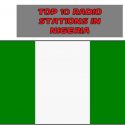

There’s a quick way to determine if RFI is the culprit: Take your radio outdoors, away from the noiseĭepending on where you live, this might only require walking with your radio to the far end of your garden/yard, or it might require hopping in your car and visiting a local park. In all likelihood, though, it’s a noise inside your home. RFI can also be caused by power line noises outdoors which have a much larger noise footprint and typically require intervention from your local utilities company/municipality. These “Wall Wart” type adapters can create a lot of RFI Honestly, most any device could be the culprit. RFI can emanate from most any modern electronic or digital device in your home: televisions, power supplies, dimmer switches, smart appliances, and even computer hard drives. Even if you can’t hear the noise, it could still be overwhelming your receiver from a different portion of the band. RFI deafens our shortwave radios by overwhelming the receiver with strong spurious signals. RFI (also known as QRM) is radio noise that is created locally and often concentrated in our homes and neighborhoods. It’s not always immediately obvious–especially if you’re new to shortwave listening.

RFI is quite often the elephant in the listening room. Let’s talk about what is most likely the culprit: Radio Frequency Interference (RFI) Of course, a number of things could be affecting your shortwave radio reception and there is, of course, the possibility the receiver is faulty–however, this is very unlikely. Thank you for your question, Andrew, and I hope you don’t mind that I share it here on the SWLing Post as I receive this question so frequently from new shortwave radio enthusiasts. Grateful for your detailed advice on what I need to do exactly to improve the number of stations I can receive. All inside the house and the wire aerial did improve the reception, but I get hardly and channels either during the day or night. I have just purchased a Tecsun PL-680 and have tried it inside my home with the telescopic and wire aerial that came with it, plugged into the antenna port and clipped to a point near the ceiling. I am not really interested in FM, but I would like to listen to international stations on SW, utilities stations, amateur broadcasts and if possible, local airports, aircraft on air band. May I ask a question please? I am very much a newbie to this. This was the beginning of the “Golden Age of Radio.” The Radio Corporation of America (RCA), parent company of the National Broadcasting Company (NBC), Columbia Broadcasting System (CBS) and the British Broadcasting Corporation (BBC) produced and commissioned shows like “The Lone Ranger”, “The Shadow”, “BBC Dramas”, “I Love a Mystery,” and there were even plenty of shows for children, such as “Let’s Pretend” and “Hop Harrigan.This morning, I received a question from Andrew, an SWLing Post reader in the UK. In the evening, the family gathered around a big “console” that was usually located in the living room, where they might spend hours listening to variety shows or comedies from favorites like Jack Benny or Edgar Bergen and Charlie McCarthy.Įveryone used their imagination to visualize all of the characters in their favorite shows. By the 1930s, most households in the U.S. In the early 1920s, radio played an important role in people’s lives, and over 500 stations were broadcasting news, music, sports, drama, and variety shows. Radio works by changing sounds or signals into radio waves, which travel through air, space, and solid objects, and the radio receiver changes them back into the sounds, words, and music we hear.Ī radio broadcast is a one-way transmission, originating from a radio station. In 1906, Marconi shared the Nobel Prize for physics with Ferdinand Braun, a German, in recognition of their contributions to the development of wireless telegraphy.
#World receiver radio in nigeria code#
He used radio waves to transmit Morse code and the instrument he used became known as the radio. In 1895, a young Italian named Gugliemo Marconi invented what he called “the wireless telegraph” while experimenting in his parents’ attic. German scientist Heinrich Hertz proved the existence of radio waves, which occur in nature. Radios send messages by radio waves instead of wires. The next advancement in telecommunications was radio, the first wireless mode of communication.


 0 kommentar(er)
0 kommentar(er)
